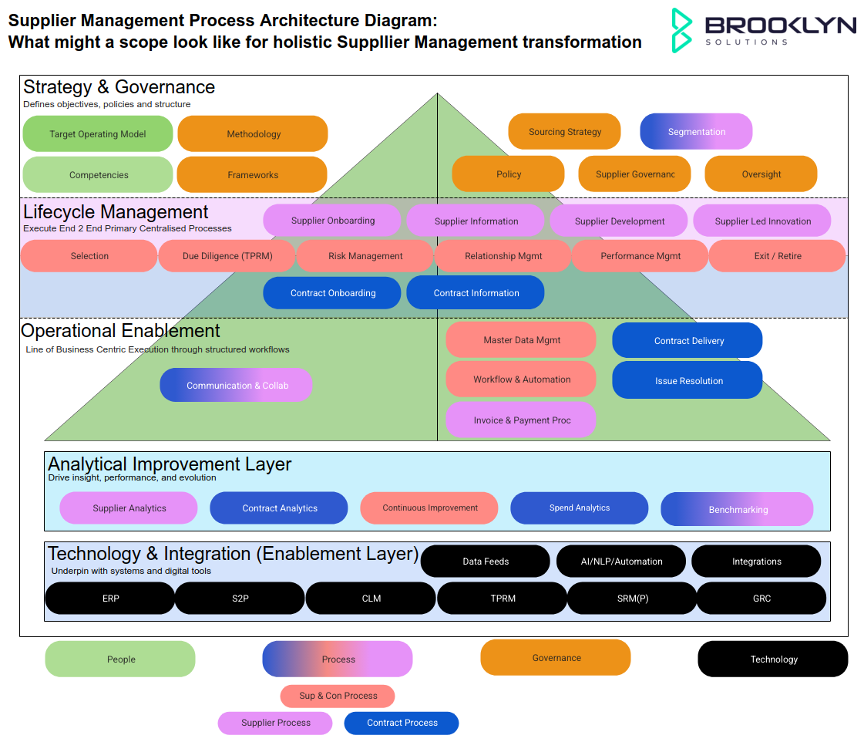Supplier management has become a multidimensional discipline that touches every part of an organisation. It requires more than operational efficiency or compliance alignment. A truly effective supplier management function must be strategic, structured, and technology-enabled.
At Brooklyn Solutions, we have developed a Supplier Management Process Architecture Framework to help organisations build or transform a unified, scalable supplier function. This blog introduces the framework and outlines how each layer contributes to consistent supplier lifecycle management, operational transparency, and business value.
Why Supplier Management Architecture Matters
Most organisations do not build their supplier management function intentionally. Instead, related processes tend to evolve within silos. Procurement teams focus on sourcing, risk teams manage third-party due diligence, and finance departments control payment workflows. The result is duplication, inefficiency, and limited visibility across the supplier base.
A structured Supplier Management Architecture resolves these issues by aligning people, processes, data, and technology around a clear governance model. Each function is connected to a shared supplier management vision, enabling consistency, agility, and measurable outcomes across the supplier lifecycle.
According to a study by McKinsey, integrated supplier management can improve supplier collaboration and reduce third-party risk exposure by as much as 30%.
The Five-Layer Supplier Management Framework
Brooklyn’s architecture consists of five interdependent layers. Each supports a critical component of supplier lifecycle management, from strategic oversight to operational execution and continuous improvement.

Layer 1: Strategy and Supplier Governance
Purpose: Define the vision, accountability structure, and policies that govern the supplier ecosystem.
This layer lays the foundation for consistent decision-making and governance in supplier management.
- Target Operating Model: Clarifies organisational design, governance structures, and decision-making authority.
- Frameworks and Standards: Leverages best practices and standards such as ISO 20400 for sustainable procurement and category management models.
- Supplier Segmentation Strategy: Categorises suppliers based on strategic importance and risk profile.
- Policies and Governance Structures: Outlines engagement rules, escalation protocols, and performance expectations.
- Oversight and Assurance: Includes mechanisms such as audits, business reviews, and compliance monitoring.
Insight: This layer must evolve alongside changing business priorities, industry regulations, and supplier risks. Aligning with globally accepted frameworks like ISO 20400 ensures consistency, accountability, and sustainability from the outset.
Layer 2: Supplier Lifecycle Management
Purpose: Enable consistent execution of supplier engagement processes from selection to exit.
This is where the rubber meets the road. It includes all critical supplier engagement stages from selection to exit:
- Selection and Due Diligence (TPRM): Evaluate suppliers across financial, operational, and ESG risk domains.
- Vendor Onboarding and Contracting: Capture key supplier data and formalise agreements through digital platforms.
- Supplier Information Management: Ensure high-quality data through centralised records and ongoing maintenance.
- Supplier Relationship and Performance Management: Monitor performance, resolve issues, and strengthen collaboration.
- Innovation and Exit Strategy: Facilitate innovation opportunities and manage supplier exits in a structured way.
Insight: A mature supplier lifecycle framework enables both standardisation and differentiation depending on the supplier tier.
Layer 3: Operational Enablement
Purpose: Support day-to-day supplier interactions through integrated workflows, automation, and data quality.
This layer represents the operating model in procurement, and how to interact with suppliers to obtain value whilst reducing manual administrative tasks:
- Supplier Master Data Management: Create a single source of truth across all systems.
- Workflow Automation: Digitise and streamline processes such as onboarding, approval routing, and escalations.
- Invoice and Payment Processing: Ensure timely and accurate transactions with clear audit trails.
- Communication and Collaboration Tools: Centralise engagement channels for improved accountability.
- Contract Delivery and Issue Management: Track contract performance and respond to deviations.
Insight: Operational clarity and strong process ownership are essential to avoid stalled transformation efforts.
Layer 4: Supplier Analytics and Continuous Improvement
Purpose: Use data to generate insight and inform decisions across the supplier lifecycle.
According to a Deloitte CPO Survey, procurement leaders who invest in supplier analytics outperform peers in cost reduction, risk mitigation, and innovation sourcing. During this layer, what gets measured gets improved. This concept introduces strategic visibility.
- Supplier and Contract Analytics: Monitor supplier performance, contract usage, and segmentation validity.
- Spend Analytics and Benchmarking: Identify trends and compare value against internal benchmarks or market standards.
- Continuous Improvement Frameworks: Feed insights back into lifecycle processes and governance routines.
Insight: Leading organisations treat analytics as an engine for transformation, not just as a reporting function.
Layer 5: Technology and Integration Enablement
Purpose: Provide the digital foundation to support scale, automation, and strategic visibility.
Although technology does not lead a transformation, as this focuses more on concept introduction and culture change, technology and solutions are an enabler to make transformations more scalable.
- Core Platforms: Examples include ERP, S2P, Contract Lifecycle Management (CLM), Third-Party Risk Management (TPRM), and Supplier Relationship Management (SRM).
- Systems Integration: Ensure supplier data and process flows are synchronised across platforms.
- AI in Supplier Management: Use artificial intelligence to surface insights, flag anomalies, and reduce manual overhead.
- Unified Architecture: Connect systems, teams, and workflows to maintain data integrity and enable continuous monitoring.
Insight: Without an integrated technology foundation, process maturity remains fragmented and visibility is limited.
Use Cases and Applications of Supplier Management Framework
The Supplier management architecture has been adopted across industry-wide customers at Brooklyn to support their transformation to supplier management processes and vendor lifecycle management. The Supplier management framework has been adopted across industries to:
- Lead procurement and third-party risk transformation at global enterprises.
- Benchmark supplier segmentation and lifecycle maturity during internal reviews.
- Establish new operating models for vendor management offices and shared service centres.
- Guide technology decisions and prioritisation during supplier management transformation.
Implementation Considerations
The five-layer model is intentionally modular. Most organisations already have elements in place, but these are often misaligned or duplicated. When implementing a Supplier management framework, our Brooklyn transformation team has helped Customers to:
- Conduct supplier management maturity assessments
- Identify high-value opportunities for transformation
- Clarify roles and responsibilities across functional teams
- Introduce scalable processes before technology investments are made
From Siloed to Strategic Supplier Management
Supplier management has become a strategic capability. It enables organisations to reduce cost, improve resilience, accelerate innovation, and meet regulatory demands such as ESG and third-party risk compliance. With a clear framework in place, businesses can unify processes and governance while gaining the agility to adapt.
The Brooklyn Supplier Management Process Architecture provides a proven foundation to transform supplier oversight from fragmented and reactive to structured and strategic. Whether you’re embarking on a wholesale transformation or seeking to harmonise and improve over time, this framework offers a proven, flexible foundation for lasting impact.
Need support with your Supplier Management Framework? Book a call with our transformation experts: Book a call
